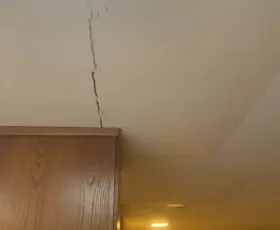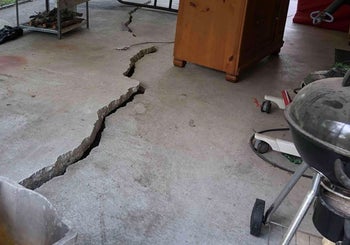Horizontal Foundation Cracks: Should You Worry?
Table of Contents
1. How Serious Are Horizontal Foundation Cracks?
2. What Causes Horizontal Cracks?
3. Foundation Cracks You Should Be Concerned About
4. Repairing Horizontal Foundation Cracks
5. Preventing Horizontal Cracks
Are you worried about one or more horizontal foundation cracks in your home? If so, this short article has what you need. We’re going to discuss the causes of horizontal foundation cracks, how serious they are, how to repair horizontal foundation cracks and more.
How Serious Are Horizontal Foundation Cracks?
Horizontal foundation cracks are serious. They’re sometimes an indication the home’s foundation has moved. However, if they appear on a basement wall, they’re probably caused by hydrostatic pressure. We’ll talk more about this below.
If you have horizontal cracks in your home, you need to contact either a foundation repair contractor or a structural engineer right away for an inspection.
The good news is horizontal cracks don’t mean your house is about to collapse. Virtually all horizontal foundation cracks can be repaired.
What Causes Horizontal Cracks?
The most common cause of horizontal cracks is hydrostatic pressure pushing against the foundation wall. Here’s how it happens:
- Poor drainage around the foundation leads to excess water in the soil.
- Excess water in the soil leads to the build-up of hydrostatic pressure which pushes against the foundation wall.
- If the hydrostatic pressure isn’t relieved by improving drainage around the foundation, the foundation wall will eventually start to bow inward and could even crack horizontally.
Concrete block foundation walls are especially susceptible to hydrostatic pressure. Of course, there are other reasons for horizontal foundation cracks, including:
- Frost heave in colder climates – Frost heave happens when water in the soil freezes, causing the soil to expand and push against the foundation wall.
- Heavy vehicles parked next to the foundation – Examples of this include large trucks and dumpsters.
A phenomenon called “differential settlement” can also cause horizontal foundation cracks. Differential settlement is when the house is settling unevenly into the soil. This puts pressure on the structure, leading to horizontal foundation cracks. For more information, see Foundation Settlement.
Foundation Cracks You Should Be Concerned About
Unlike vertical foundation cracks, all horizontal foundation cracks are serious. However, some are more serious than others. For example, a wide horizontal foundation crack on a foundation wall accompanied by significant bowing is more serious than a small horizontal crack without bowing.
That doesn’t mean you should ignore smaller horizontal foundation cracks, though. All horizontal foundation cracks are serious and need to be inspected by either a foundation repair contractor or a structural engineer. Don’t delay. The longer you wait, the more expensive the repair could be
Other horizontal foundation cracks you’re likely to see include:
- Stair step cracks in brick or masonry
- Cracks that are wider at one end
- Cracks that are getting bigger
- Cracks that are more diagonal than horizontal
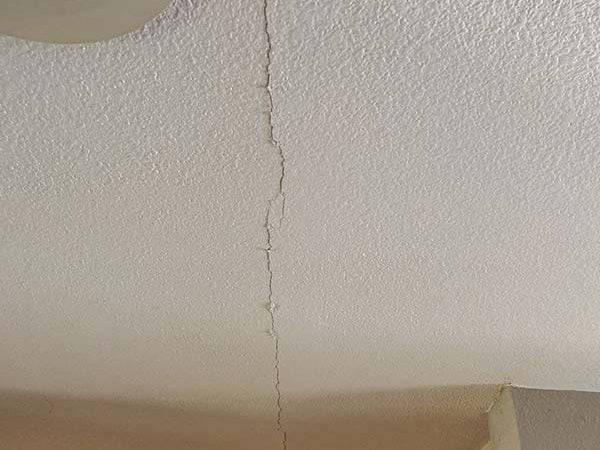
In addition to horizontal cracks, you might also see interior cracks in your home such as:
- Cracks that run across the ceiling and down a wall
- A series of vertical cracks next to each other – One hairline vertical crack on a poured foundation wall was probably caused by shrinkage during the concrete curing process and is not something you should worry about. However, several vertical cracks next to each other is a sign something else is going on.
Repairing Horizontal Foundation Cracks
The chosen repair solution for a horizontal foundation crack will, of course, depend on the type of foundation and what caused the cracks. The following are common repair solutions for horizontal foundation cracks:
Wall Plate Anchors
If your basement wall is cracked (and possibly bowed), wall plate anchors solve the problem by connecting metal brackets on the inside of the basement wall to an anchor buried in the yard about 10 feet or so from the foundation wall. This braces the wall and will, over time, pull it back toward its original position. Excavation outside the foundation wall is required in order to place the anchors.
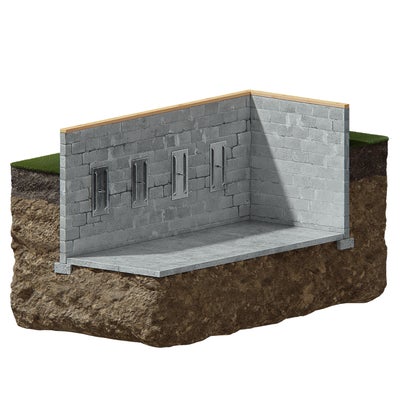
Carbon Fiber Wall Straps
Horizontal foundation cracks are also repaired using strong carbon fiber wall straps. Carbon fiber is an extremely strong material used in commercial aircraft. Carbon fiber straps close horizontal foundation cracks, halt inward bowing, and stabilize the foundation wall.
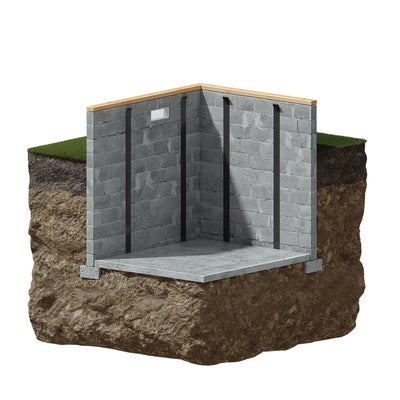
Helical Wall Anchors (Tiebacks)
Helical tieback wall anchors are another repair option for stabilizing a bowing and/or cracked foundation wall. Unlike wall plate anchors, helical tiebacks don’t require excavation outside the foundation wall. They are installed from the inside. After the bracket is attached to the wall, the tieback is drilled through the bracket and into the soil at a downward angle.
C-Channel Wall Anchors
C-Channel wall anchors look like steel wall beams and are yet another way to stabilize a cracked, bowing foundation wall. They are particularly effective at correcting basement walls that have started to sheer at the bottom. The anchors work to stabilize and straighten the wall.
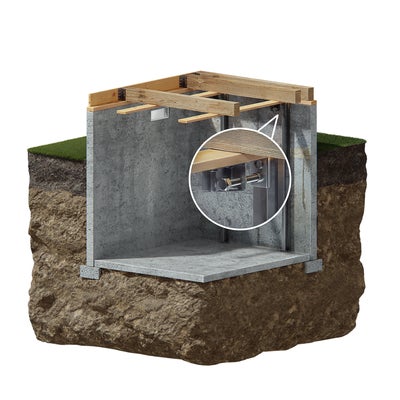
Push piers
If the horizontal foundation cracks were caused by differential settlement, push piers might be the chosen solution. The installation process involves attaching steel brackets to the foundation and then driving heavy-duty steel push piers through the brackets and down into load-bearing soil. Once the piers are in place, synchronized hydraulic jacks lift the building.
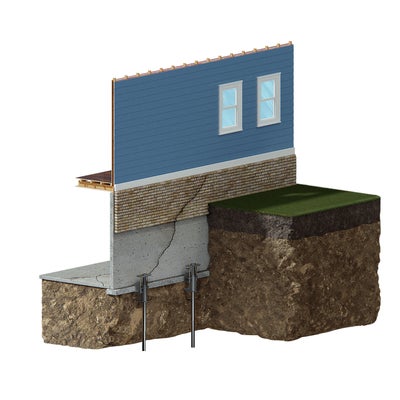
Helical piers
Helical piers look something like giant corkscrews and are used for both new construction projects requiring a deep foundation and for stabilizing existing foundations experiencing differential settlement. The piers are turned into the soil to the desired depth, and then synchronized hydraulic jacks lift the building back up.

Preventing Horizontal Cracks
Since most foundation problems, including horizontal foundation cracks, are caused by water, you can help prevent trouble by controlling groundwater around your foundation. You’re aiming for soil that isn’t saturated with water. You want good drainage around the foundation. Here are some ways to do that:
- Regrade your yard, if necessary – The yard around your home should slope away from the foundation. If it doesn’t, water will drain toward the foundation and cause trouble. You can hire a landscaper to do this, or you could do it yourself.
- Don’t forget to clean your gutters regularly – If your gutters are clogged, water will flow over the side of your home and into the soil around the foundation.
- Install downspout extensions, if necessary – Many times, downspouts are too short and release water next to the foundation. Downspout extensions are inexpensive, easy to install, and will carry water away from the foundation before releasing it.
- Install an underground downspout connected to a bubbler pot – Another option for controlling runoff from your gutters is an underground downspout connected to a bubbler pot situated in your yard 10 feet or so from the foundation. When the bubbler pot is empty, it sits flush with the lawn and is virtually invisible. When it rains, runoff flows into the underground downspout toward the bubbler pot. When the pot is full, it pops up and releases the water away from the foundation.
- Don’t plant anything near your foundation – Ideally, all vegetation should be kept away from the foundation. You don’t want a reason to pour water into the soil around the foundation.
- Install a drain tile system, exterior or interior – A drain tile system is a foundation waterproofing gold standard. If you can afford it, have one installed. A drain tile system prevents excess water from building up in the soil around the foundation. There simply is no better way to control groundwater around a foundation.
An exterior drain tile system is installed around the outside perimeter of the house at the footing level. A shallow trench is dug, lined with gravel, and then a perforated drain pipe is placed in the trench and covered with more gravel. The excavated soil is then replaced. Excess water in the soil enters the perforated drainage pipe and gets directed to a sump pit. When the sump pit fills with water, a sump pump turns on to expel the water away from the foundation. Depending on how your yard is graded, a sump pump might not be necessary.
If you have one or more horizontal foundation cracks in your Northern California home, contact us today for an inspection and estimate.
More Resources
Publish Date:
Last Modified Date:

Our Locations
2333 Courage Dr. Suite C
Fairfield, CA 94533
1161 N Fair Oaks Ave
Sunnyvale, CA 94089

